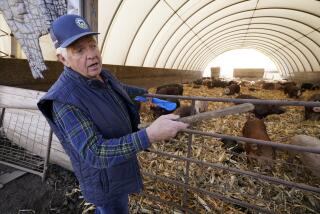U.S. to Aid Island’s War on Wild Pigs
- Share via
More than a century of rooting and snorting may be coming to an end on Santa Cruz Island as the federal government earmarks $2.1 million for “pig-proof” fencing, the first step in corralling and killing off thousands of destructive wild swine.
The 44 miles of wire fencing will stretch over the jagged mountain ridges and deep valleys of Santa Cruz, the largest of the eight Channel Islands at 60,645 acres. The pigs will either be trapped and killed or stalked by sharpshooters on foot and in helicopters. All pigs should be eradicated in about six years, park officials said.
“I’m jumping up and down on this one,” said Tim Setnicka, superintendent of Channel Islands National Park. “If you are in charge of a national park with 5,000 pigs ripping up plants and terrorizing the environment, you have to be ecstatic to get money to move forward on this.”
Not everyone is happy about the plan. Animal rights activists say it’s inhumane to shoot the pigs and urged the park to use contraceptives or euthanasia instead.
The fencing funds are included in the Interior Department budget proposal, which still needs congressional approval. If granted, the money should arrive by next February and the fencing can begin.
The multimillion-dollar fence is not merely pork-barrel politics, officials said.
At stake is the continued existence of endangered animal species such as the island fox and plants including the Santa Cruz bushmallow.
“We are on the verge of losing species,” said Gary Davis, an ecologist and science advisor to the park. “How long can we hold off extinction of the island fox? This is like triage at an accident scene. You need to stop the bleeding before you set the leg. Removing the pigs is a crucial step.”
Golden Eagles Feed on Pigs and Foxes
Killing the pigs would eliminate the major food source for the golden eagle, which also preys on the island fox.
“We found the first golden eagle nest in 1997,” Setnicka said. “Prior to that, they have been in the park, but we have never seen them nesting. We want the bald eagles back and then to make the goldens transient. That will allow the foxes to recover.”
The park plans to reintroduce bald eagles to the islands this summer. Bald eagles, which feed on carrion and fish, left the islands in the late 1950s when DDT in the environment thinned their eggshells. They don’t eat island foxes.
Pigs, on the other hand, survive easily on the islands.
Today’s occasionally boorish residents are descended from a herd of domestic pigs kept on Santa Cruz by one M.J. Box of Santa Barbara. Court records show that, in 1853, Box borrowed $2,000 from Thomas Wallace More, using the pigs as collateral.
When he didn’t pay up in time, More tried to collect the swine. But he found they had “become wild from abandonment and neglect.”
“There is nothing left but a certain number of wild swine ranging among the precipitous hills of Santa Cruz, unapproachable, untamable and daily hunted by the inhabitants of said island as fierce natured and nuisances,” More’s lawyer wrote.
Box, meanwhile, is said to have “absconded” from the state.
Wild pigs are hairy, sometimes tusked and eat just about anything, including each other, biologists say. They can also double their population every four months.
In a three-year effort beginning in the early 1990s, the park service killed thousands of wild pigs on the 53,000-acre Santa Rosa Island.
“They are quite intelligent,” Davis said. “They will hunker down in the bush when they hear a helicopter.
“After hunting them for a while, it gets harder and harder. Mom gets wise to the helicopter, and the kids do too.”
Santa Cruz is the last wild pig stronghold in the Channel Islands chain.
A similar anti-swine effort is afoot on Catalina Island off the coast of Los Angeles.
Peter Schuyler, director of ecological restoration for the Santa Catalina Island Conservancy, said 17 miles of pig-proof fencing was erected in 1999. He hopes the pigs will be gone in two years.
Those pigs, imported from Santa Cruz in the 1930s for organized boar hunts, also have outstayed their welcome, he said.
“They eat acorns, so trees don’t regenerate,” Schuyler said. “They rototill soil, which leads to erosion. They displace native animals and reduce nesting sights.
“They are barnyard pigs gone wild.”
Yet shooting seems cruel and unnecessary to some.
“We don’t understand why they are being slaughtered in the name of conservation,” said Stephanie Boyles, a wildlife biologist with People for the Ethical Treatment of Animals. “They are there because we put them there--it is our fault they exist there in the first place.”
Contraceptive Darts, Euthanasia Urged
Boyles proposed shooting the animals with darts full of contraceptives. Failing that, the pigs should be trapped and euthanized, she said.
But Davis said using dart contraceptives is almost impossible because it requires tracking the same animal and shooting it several times during the length of its ovulation cycle.
And shooting pigs in the head after they are trapped is as humane as the way cattle are killed in slaughterhouses, he said.
Pigs can’t be brought back to the mainland because some carry diseases that could infect domestic livestock, park officials said.
The pig program will probably not affect tourism on Santa Cruz, and the long-term effect will be positive, Setnicka said.
“The parks will last forever,” Setnicka said. “It will be front-end investment for a very long-term benefit.”
More to Read
Sign up for Essential California
The most important California stories and recommendations in your inbox every morning.
You may occasionally receive promotional content from the Los Angeles Times.













